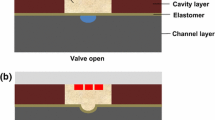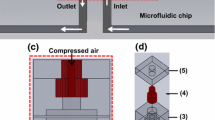Abstract
A new induction-heating-based microvalve using paraffin composite is successfully demonstrated in this paper. The microvalve consists of a polydimethylsiloxane (PDMS) chip, a PDMS diaphragm, a column of paraffin composite, a glass paraffin composite chamber, a glass substrate and three excitation coils. Joule heat is induced by the eddy current inside the paraffin composite relied on induction heating. One advantage of the microvalve is that there is no physical contact between the heater and the external power supply circuit, which resulted in a simple structure and a relatively easy fabrication process. The experiments shows that the thermally actuated microvalve can close a flow of 2.75 μL/s within 8–10 s against a pressure of 10 kPa with an input power of 1.12 W, and when closed, the valve can passively withstand an inlet pressure up to 40 kPa under the input power of 2.31 W without leakage. The microvalve is very suited for flow control in portable lab-on-a-chip systems.








Similar content being viewed by others
References
Allwyn B, Homburg FGA, Somhorst MGAM, Dietzel A (2011) A layered modular polymeric μ-valve suitable for lab-on-foil: design, fabrication, and characterization. Microfluid Nanofluid 11:663–673
Baek SK, Yoon YK, Jeon HS, Seo S, Park JH (2013) A wireless sequentially actuated microvalve system. J Micromech Microeng 23(4):045006
Fu C, Rummler Z, Schomburg W (2003) Magnetically driven micro ball valves fabricated by multilayer adhesive film bonding. J Micromech Microeng 13(4):S96–S102
Goettsche T, Kohnle J, Willmann M, Ernst H, Spieth S, Tischler R, Messner S, Zengerle R, Sandmaier H (2005) Novel approaches to particle tolerant valves for use in drug delivery systems. Sens Actuators A Phys 118(1):70–77
Jadhav AD, Yan B, Luo RC, Wei L, Zhen X, Chen CH, Shi P (2015) Photoresponsive microvalve for remote actuation and flow control in microfluidic devices. Biomicrofluidics 9(3):034114
Kim JH, Na KH, Kang CJ, Jeon D, Kim YS (2004) A disposable thermopneumatic-actuated microvalve stacked with PDMS layers and ITO-coated glass. Microelectron Eng 73:864–869
Li XT, Wang AQ (2012) High-sealing microvalves for PCR. Adv Mater Res 383:2025–2030
Li HQ, Roberts DC, Steyn JL, Turner KT, Yaglioglu O, Hagood NW, Spearing SM, Schmidt MA (2004) Fabrication of a high frequency piezoelectric microvalve. Sens Actuators A Phys 111(1):51–56
Liu B, Yang J, Zhang Z, Yang J, Li D (2018) A phase change microactuator based on paraffin wax/expanded graphite/nickel particle composite with induction heating. Sens Actuators A Phys 275:129–136
Megnin C, Kohl M (2013) Shape memory alloy microvalves for a fluidic control system. J Micromech Microeng 24(2):025001
Ogden S, Bodén R, Hjort K (2010) A latchable valve for high-pressure microfluidics. J Microelectromech Syst 19(2):396–401
Ogden S, Klintberg L, Thornell G, Hjort K, Bodén R (2014) Review on miniaturized paraffin phase change actuators, valves, and pumps. Microfluid Nanofluid 17(1):53–71
Oh KW, Ahn CH (2006) A review of microvalves. J Micromech Microeng 16(5):13–39
Oh KW, Rong R, Ahn CH (2005) Miniaturization of pinch-type valves and pumps for practical micro total analysis system integration. J Micromech Microeng 15(12):2449
Park JM, Cho YK, Lee BS, Lee JG, Ko C (2007) Multifunctional microvalves control by optical illumination on nanoheaters and its application in centrifugal microfluidic devices. Lab Chip 7(5):557–564
Ramalingam N, Rui Z, Liu HB, Dai CC, Kaushik R, Ratnaharika B, Gong HQ (2010) Real-time PCR-based microfluidic array chip for simultaneous detection of multiple waterborne pathogens. Sens Actuators B Chem 145(1):543–552
Takao H, Miyamura K, Ebi H, Ashiki M, Sawada K, Ishida M (2005) A MEMS microvalve with PDMS diaphragm and two-chamber configuration of thermo-pneumatic actuator for integrated blood test system on silicon. Sens Actuators A Phys 119(2):468–475
Teymoori MM, Abbaspour-Sani E (2005) Design and simulation of a novel electrostatic peristaltic micromachined pump for drug delivery applications. Sens Actuators A Phys 117(2):222–229
Wang Q, Zuo S, Yao H, Ho T Y, Li B, Schlichtmann U, Cai Y (2017) Hamming-distance-based valve-switching optimization for control-layer multiplexing in flow-based microfluidic biochips. In: Design automation conference (ASP-DAC), pp 524–529
Yang B, Lin Q (2009) A latchable phase-change microvalve with integrated heaters. J Microelectromech Syst 18(4):860–867
Yang XE, Holke A, Jacobson SA, Lang JH, Schmidt MA, Umans SD (2004) An electrostatic, on/off microvalve designed for gas fuel delivery for the MIT microengine. J Microelectromech Syst 13(4):660–668
Yu N, Wang S, Liu H, Ge P, Nan J, Ye S, Zhang JH, Yang B (2018) Integrated obstacle microstructures for gas-liquid separation and flow switching in microfluidic networks. Sens Actuators B Chem 256:735–743
Zhao YF, Xiao M, Wang SJ, Ge XC, Meng YZ (2007) Preparation and properties of electrically conductive PPS/expanded graphite nanocomposites. Compos Sci Technol 67(11–12):2528–2534
Acknowledgements
This work was financially supported by National Natural Science Foundation of China (No. 51675014), Beijing Natural Science Foundation, China (No. 3192010 and No. 3172005) and National Innovative Methodology Project of China (No. 2018IM0301004).
Author information
Authors and Affiliations
Corresponding author
Additional information
Publisher's Note
Springer Nature remains neutral with regard to jurisdictional claims in published maps and institutional affiliations.
Rights and permissions
About this article
Cite this article
Liu, B., Yang, J., Yang, J. et al. A thermally actuated microvalve using paraffin composite by induction heating. Microsyst Technol 25, 3969–3975 (2019). https://doi.org/10.1007/s00542-019-04373-8
Received:
Accepted:
Published:
Issue Date:
DOI: https://doi.org/10.1007/s00542-019-04373-8




